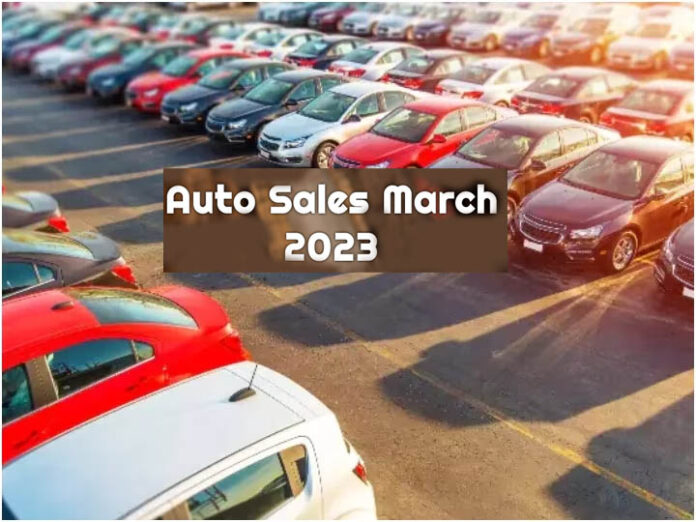
With the top three carmakers Maruti Suzuki, Hyundai and Tata Motors posting their highest-ever sales volumes during Financial Year 2023, the passenger vehicle industry done the year with 38.89 lakh sales, scoring a growth of 27% against 30.69 lakh of last year. SUVs contributed a major portion of the sales volumes for OEMs.
The previous highest for PV sales in a fiscal year was at 33.77 lakh units, recorded in FY19. According to industry estimates, the retail sales for FY23, based on vehicle registration data from regional transport offices (RTOs) was at 38 lakh against 30.7 lakh last year, marking a growth of almost 24%. Both the wholesale and the retails were the highest-ever for the industry.
Going forward, geopolitical conditions (commodity, fuel prices), economic growth, interest rate hike and loan rates could be possible headwinds for the industry. The shortage of semiconductors is expected to continue for some more time. Maruti Suzuki projects a growth of 5% to 7% for the next fiscal, expecting Passenger Vehicle sales to be around 40.5 lakh to 41 lakh.
According to Motilal Oswal, “Overall dispatches were better than expected for two wheelers and commercial vehicles while the numbers were in line for PVs and tractors. Volume growth for March 2023 indicated healthy demand during the festive season followed by higher dispatches before BSVI Phase-II transition (to be implemented from April 2023).”
“Two wheeler domestic dispatches continued to improve but broad-based recovery is yet to happen. April 2023 would see price hikes ranging between INR 800 and INR 1500 due to OBD-2 transition which is likely to impact demand adversely in the near term,” it said.
ICRA estimates two wheeler volumes (domestic+exports) to register a growth of 6-9% YoY in FY24 on a severely contracted base; the domestic market is expected to drive the recovery with export outlook remaining weak. “Retail offtake, after remaining healthy during the festive season, lagged pre-pandemic levels over the past few months, dampening hopes of a sustained recovery. Rural demand remained weak, thereby impacting the entry level motorcycle segment, and its recovery remains key. Fears of impact of heavy rainfall on rabi yields and a possible El Nino occurrence on monsoon precipitation thus remains a concern/monitorable,” Shamsher Dewan, Senior Vice President & Group Head – Corporate Ratings, ICRA Limited said.
Passenger vehicles
As per industry estimates, total Passenger Vehicle wholesale volumes during the month stood at 3.36 lakh units, as against 3.22 lakh last year, marking a growth of 4.4%. This is the highest-ever wholesale for the month of March. Stock in the industry has been reduced to 2.04 lakh units by month-end from 2.18 lakh units in the beginning of the month.
Healthy replacement demand, relatively stable semiconductor supplies, coupled with an extent of prebuying prior to the implementation of second phase of BS-VI emission norms from April 1, 2023 acted as tailwinds to demand in March 2023. However, an increase in cost of ownership (led by hike in vehicle prices and repo rates), remained a headwind for the industry, said ICRA.
Most OEMs have already transformed their product line-up to comply with the upcoming OBD-2 norms leading to price hikes.
Maruti Suzuki’s sales for passenger cars dropped to 83,714 units in March 2023, compared to 99,639 units in March 2022. For Mini cars (Alto, S-Presso), sales were down to 11,582 units in March this year, as against 15,491 units in March last year. For compact cars (Baleno, Celerio, Dzire, Ignis, Swift, Tour S, WagonR), sales dropped to 71,832 units in March 2023, from 82,314 units in March last year. The highest sales drop was witnessed for the company’s mid-size Ciaz which were down to just 300 units, from 1,834 units in March last year.
From 1st April, Maruti Suzuki has also stopped the production of the Maruti 800. Overall, the hatchback industry has declined in the last two years due to the affordability factor. The growth in income for hatchback consumers has not been as high as the increase in vehicle acquisition cost and that means the affordability factor has come down and the consumers in this segment are very price sensitive, said Shashank Srivastava, Executive Officer- Marketing & Sales, Maruti Suzuki.
Utility vehicle (Brezza, Ertiga, S-Cross, XL6, Grand Vitara) sales stood at 37,054 units in March 2023, compared to 25,001 units in March last year. Sales for Eeco van also grew to 11,995 units, as against 9,221 units in March 2022. The maker of WagonR and Swift said that the rural growth has been slightly higher than urban growth in the recent months. This came on the back of a good monsoon for the third consecutive year.
Going forward, experts believe there may be irregular monsoon due to El Nino effect which may impact the rural sentiment.
Tarun Garg, Chief Operating Officer, Hyundai Motor India, said, “Despite global headwinds, we see momentum in the Indian auto industry backed by strong India growth story led by gen MZ.”
Shailesh Chandra, MD, Tata Motors PV, said the demand for personal vehicles is expected to remain robust with the trend of electrification further strengthening. However, the growth rate of the PV industry may moderate due to a strong base effect as well as macro factors including hardening interest rates, rising inflation, and the cost impact from progressive regulatory norms.” The company is carefully monitoring the supply situation, particularly semiconductors and any potential waves of Covid, he said.
Veejay Nakra, President, Automotive Division, M&M, said, “Our SUV business recorded all-time high numbers, with a growth of 31% in March 2023, while it recorded a 60% overall growth in FY23, on the back of good demand across the portfolio.”
Two-wheelers
According to ICRA, demand in the two-wheeler segment was supported to an extent by pre-buying prior to the implementation of second phase of BS-VI emission norms from April 1, 2023, even as demand sentiments continue to remain sombre. The rural demand has improved to an extent, but it continues to remain weak, thereby impacting the entry level motorcycle segment, and the industry volumes.
Country’s largest two wheeler maker Hero MotoCorp total motorcycle sales for the month stood at 4.85 lakh and scooter sales were recorded at 33,446 units.
TVS iQube electric recorded sales of 15,364 units in March 2023 as against sales of 1,799 units in March 2022.
Devashish Handa, Executive Vice President, Sales, Marketing and After Sales, Suzuki Motorcycle India, said the company attained its highest-ever monthly sales for March.
B Govindarajan, CEO, Royal Enfield, said that the company’s motorcycles, like the Hunter 350 and Super Meteor 650, have attracted new customers into its fold. The Hunter 350, within six months of its launch, has a 1 lakh-strong community.
Commercial vehicles and three-wheelers
Shamsher Dewan of ICRA said that for the domestic CV sector, continued traction in construction, mining and infrastructure activity and replacement demand, coupled with some extent of pre-buying prior to the implementation of second phase of BS-VI emission norms from April 1, 2023 acted as tailwinds to demand in March 2023. However, the increase in repo rates, resulting in higher cost of financing, remained as a headwind.
Girish Wagh, Executive Director, Tata Motors, said, “Q4 FY23 growth was driven by the robust demand for heavy trucks required to service the strong infrastructure push by the Government plus increased activity in e-commerce, construction, and mining. Higher replacement demand, advance buying in anticipation of price hikes, and year-end buying to claim depreciation benefits, further buoyed the demand towards the end of the quarter. However, the demand for small and light commercial vehicles continued to be impacted due to high interest rates and high base effect.”
Wagh said that with the government’s continuing thrust on infrastructure development, Tata Motors remains optimistic about the overall CV demand in FY24 while maintaining a close watch on geopolitical developments, interest rates, fuel prices and inflation.
Vijay Nakra of M& M said, “The Pik-up (LCV 2-3.5T) segment recorded the highest ever annual volume with a strong 43% growth, consolidating its leadership position. We would like to thank our associates, dealers, partners, suppliers, and customers, who have made this a remarkable year”.
Tractors
Healthy rural cash flows, aided by four consecutive normal monsoons, continued to aid the demand for the tractor industry, even as fears regarding impact of unseasonal rainfall on rabi yields and effect of a possible El Nino on south-west monsoon performance have emerged and would need to be monitored.
Hemant Sikka, President, Farm Equipment Sector, Mahindra & Mahindra, said, “Increase in crop output, mandi prices staying firm, government support for increase in MSP for major crops and increase in wages under MGNREGA scheme will help improve the financial security of rural households and boost tractor demand in the coming months.”
Despite the festive season in March, retail sales were impacted due to unseasonal rainfall and crop damage in certain regions. However, with continued support from the government, better crop prices, improved finance availability and good water reservoir levels, we expect similar demand momentum to continue across geographies in the coming quarter, Escorts Kubota said.









